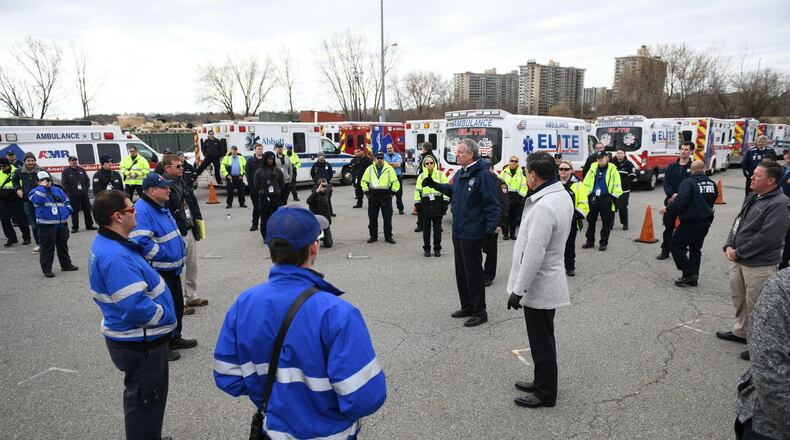In the age of coronavirus, after any 911 call, David Fisher is among many Georgia medics who are on the brink of being sidelined — or worse.
He is wearing a respirator mask that expired three days ago. If it breaks or tears in an encounter with a patient, he will be ordered into isolation for 14 days. While he is quarantined, he isn’t on the priority list for testing. Most likely, even medics who show symptoms may only be checked by a doctor before being ordered back on a truck.
“I’ve never worked in conditions like these,” Fisher said.
» COMPLETE COVERAGE: Coronavirus in Georgia
» MORE: Coronavirus and Georgia hospitals
While EMS agencies say they are doing their best to protect their crews, they say they are not getting resources provided to other health care providers to help respond to the crisis. As a result, concerns are rising to a fever pitch that so many medics will become sick or ordered into isolation that there won’t be enough left to respond to emergency calls.
In just a matter of weeks, thousands of EMS workers across the U.S. have been taken off rescue vehicles and ambulances and ordered into quarantine, bringing ambulance services in some areas to a breaking point as 911 calls spike to crisis levels. As of early Wednesday, at least 569 first responders had been diagnosed with COVID-19, according to a real-time database established by the International Association of Fire Chiefs. Last week, in just one day in New York City as many as 150 paramedics were ordered into isolation after exposure to the virus. With New York crews stretched thin, the federal government last week dispatched some crews from Georgia and other states to help with the crush of calls.
Yet no one has numbers showing the true extent of the crisis. So far, the fire chiefs’ database doesn’t include information from many ambulance services run by hospitals, governments or private companies.
In Georgia, among EMS providers that have not provided information are Atlanta Fire Rescue and EMS and Grady Emergency Medical Services. The few Georgia entities that have say at least two dozen state EMS workers have been quarantined just since Tuesday. In the past few weeks, some ambulance providers say that dozens of medics have been quarantined but only a handful have tested positive for the disease, including some in south Fulton. But other paramedics who contacted the AJC said they had also contracted the infection but did not want to be identified for fear of losing their jobs.
The agencies said they expect many more to be sidelined or fall ill as the surge hits later this month.
For now, local EMS agencies are banking their resources and economizing on supplies, waiting for the surge in patients. As more people are staying home, automobile wrecks and other accidents have fallen, resulting in fewer 911 calls. In response, most EMS agencies are scaling back their crews.
That may make it challenging for those agencies to ramp up quickly to handle a surge in COVID-19 cases in Georgia, said Terence Ramotar, director of government affairs in the southeast region for American Medical Response, which is the exclusive 911 provider for DeKalb County.
“This is the calm before the storm,’” Ramotar said. “When the storm comes, we’re afraid that other agencies, especially in rural areas, won’t be prepared, or financially sustainable, to get through that storm.”
‘Kamikaze mission’
Despite medics’ high risk of exposure, they are not a priority when it comes to getting the resources they need.
Emotions are running so high that some are calling for first responders to refuse to go into hazardous situations without proper protective attire. And that doesn't just mean 911 calls for patients who may be exhibiting symptoms of COVID-19. They say that goes for all patients.
"We are in the front lines of this, and we're not going to car crashes, cardiac arrest, childbirth calls unless we have a safe environment that we can send these EMS workers into,'' said Matt Zavadsky, president of the National Association of Emergency Medical Technicians, headquartered in Mississippi and representing more than 72,000 EMTs and paramedics across the U.S. "If we don't have gowns, goggles and masks, we're not going.
“We’re not going to send our workforce on a kamikaze mission.”
EMS leaders, including Gary Ludwig, a licensed paramedic who is president and chairman of the board of the IAFC, want Congress to instruct the Federal Emergency Management Agency to provide public assistance grants to EMS organizations. That money could pay for protective equipment and provide overtime to backfill vacancies created by the quarantines.
They also want EMS workers to have priority for testing. By law, doctors and nurses at hospitals, as well as hospitalized patients, have priority over EMS workers.
» RELATED: Hospitals, state scramble to prepare for coronavirus surge
» MORE: Health care workers in harm's way in coronavirus battle
Another push would be to allow EMS agencies to be reimbursed for providing treatment to patients in their homes, which could be supplemented by telehealth services. Up until recently, agencies only got federal reimbursement when they transported patients to emergency rooms at hospitals, then the government days ago issued a waiver that allows agencies to be reimbursed for transports to facilities other than hospitals, such as doctor offices or clinics.
Other obstacles to funding remain, and every health care system in the nation is competing for the same resources first responders need.
"What we've seen in this case, state and local governments are dealing with this crisis themselves and don't have the bandwidth to file these claims on behalf of ambulance services,'' said Tristan North, vice president for government affairs for the Sacramento-based American Ambulance Association.
Risk of exposure
Before the coronavirus outbreak, EMS has been a low priority for government support in many places. Fulton County, for example provides no subsidy to ambulance services to cities in the south Fulton area. That has resulted in chronic delays in response to emergencies because of a shortage of transport vehicles and manpower.
Some in the local EMS community bristled last week when Fulton County commissioners approved a $10 million disaster relief package for COVID-19 needs. None of that money was dedicated to buy protective gear for medics, such as gowns, eye covers and masks, or to support overtime to backfill the vacancies of medics who are quarantined or who become ill.
“It’s just a terrible situation all the way around,” said Joy Slaughter, an EMT-advanced south of Augusta who provides stress management for her peers. “There’s all these policies that dictate that medics wear those coverall suits, and you do all these things before you go on the next call.
“But that’s not reality right now,’’ she said. “Medics are not being provided with the proper PPE they need. And that makes them feel every more exposed than they may actually be.”
Many medics will have to consider what they will and won’t tolerate, Slaughter said. The single parent of a young child may not have the same comfort level to exposure as someone else, she said.
“We look at each situation and say we’re not going to send them into a kamikaze situation, but those definitions will vary by individual,’’ Slaughter said. “It just comes down to individual choice.”
David Fisher, the east-central Georgia paramedic, said he believes that he will be OK at work and has an obligation to care for patients, even though he must enter caller’s homes alone, without a backup to help him with procedures like CPR and intubation that increase his risk of exposure.
His daughter, Jessica, who lives in Augusta, made him a cover-up that he wears over his three-day-old N-95 mask. She is worried about her father, who is approaching the age that is most susceptible to the virus.
“My father is 60-years-old and still working,” said Jessica Fisher, who also sewed 100 additional for EMS crews and some of clients of her mobile chiropractic service. “It’s not easy.”
About the Author
Keep Reading
The Latest
Featured





